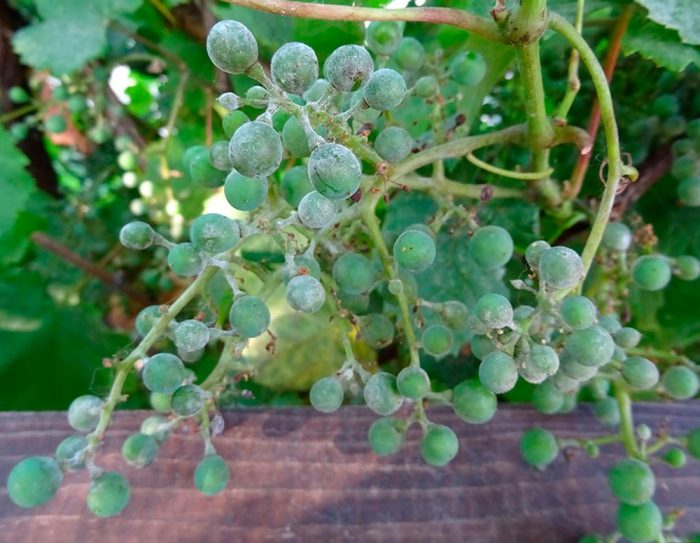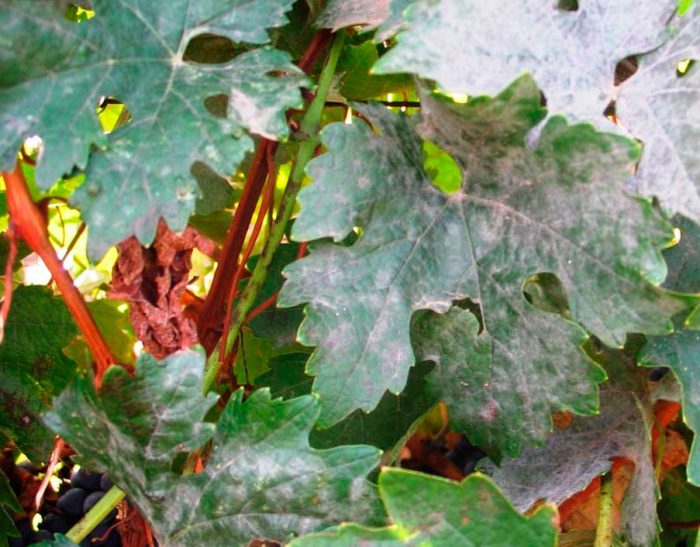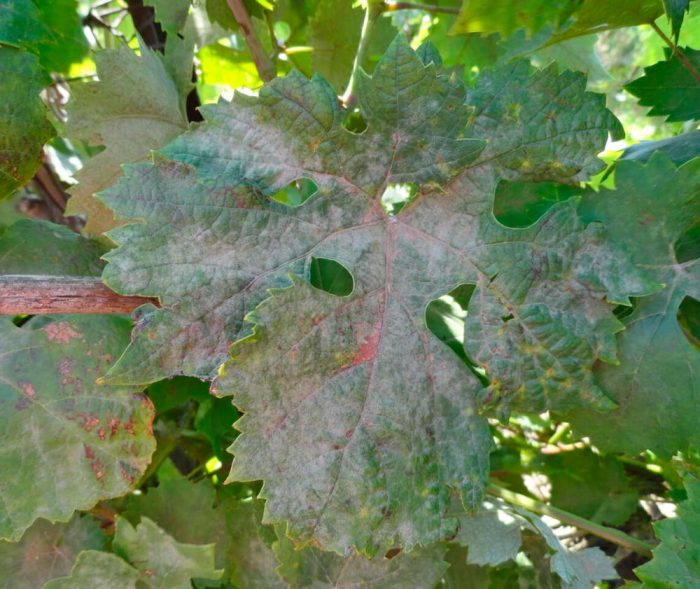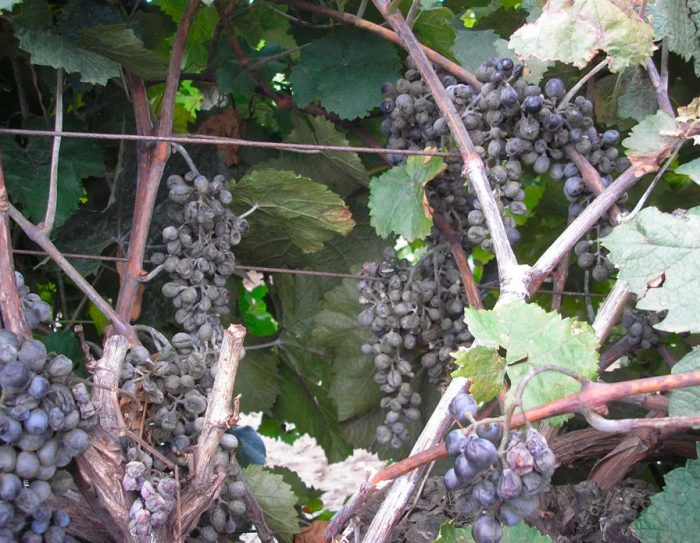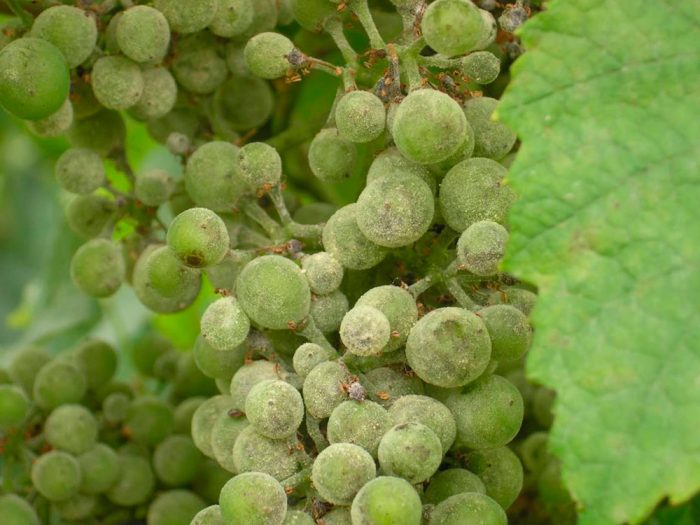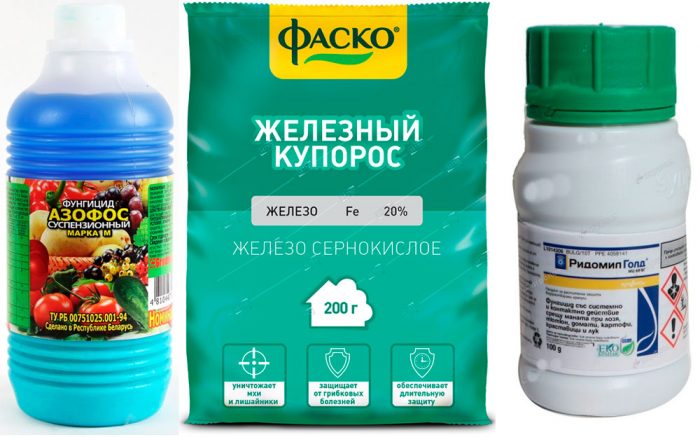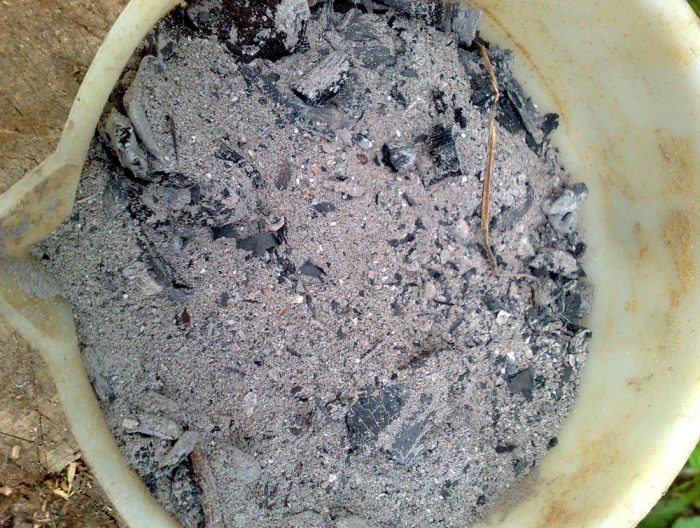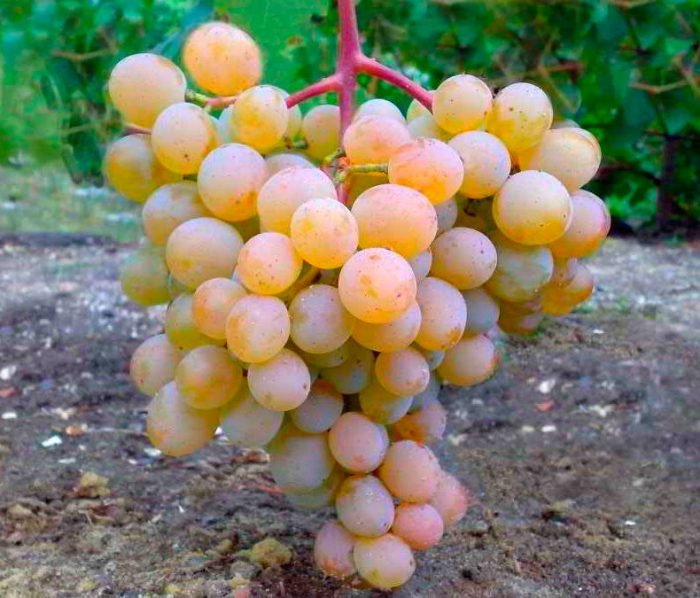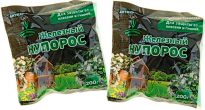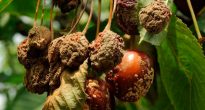Oidium is a fungal disease that affects grapes. In other cultures, this disease is known as powdery mildew (not to be confused with downy mildew, or downy mildew), or ash. The causative agent of such a disease is Oidium Tuckeri Berk, it came to Europe from North America, and was first discovered in 1845 by the gardener Tucker in England. After only 5 years, oidium has already spread throughout European territory. This disease caused particular damage to the vineyards of France, they were saved only because a highly effective remedy in the fight against powdery mildew was found - this is sulfur.
Content
Features of the disease
In spring, when the active growth of grape stems begins, on the bush you can find growths that lag behind in development. The foliage that unfolds on such growths is curly, and its surface partially or entirely covers a whitish-gray bloom. By June, this bloom can be found both on the upper and lower surfaces of the leaf plates, while the inflorescences, upper parts of the stems and clusters look as if they were sprinkled with ash or flour on top. Further, the dying off of diseased inflorescences is observed, and the affected fruits dry up. Those sick berries that are the size of a pea crack, and also dry out in drought and heat.
This disease can destroy almost the entire crop, while almost all European grape varieties are susceptible to powdery mildew. The duration of the incubation period (the time from the moment of infection to the formation of mycelium plaque) is 1–2 weeks. The most active growth of mycelium is observed at an air temperature of 25 to 30 degrees, however, its development does not stop even in cooler weather. Powdery spreads very quickly in case of thickening of the plantings (due to poor ventilation), and if there are a lot of leaves on the bushes.
Mildew or oidium
As mentioned above, mildew for grapes is powdery mildew, while mildew for this culture is downy mildew, or peronosporosis. These diseases are very different from each other, and they are caused by different pathogens. What unites them is that both of these diseases are fungal, as well as the fact that they can destroy almost the entire grape harvest. The signs of these diseases are also very different from each other.A detailed description of the symptoms of oidium can be found above. If the grapes are sick with mildew, then pale yellow oily specks form on the front surface of its foliage, after dew or fog falls on the seamy surface of the diseased leaves, a bloom appears, after a while it becomes brown and dries up. Most often, the young foliage of grapes is affected by mildew, as well as inflorescences that become brown, stems (blackening spots appear on them) and unripe fruits (they become dark in the region of the stalk and fly around). If the grapes do not fly around, they will still taste sour. If at the time of defeat by mildew there are already fully ripe fruits on the bush, then they will not suffer.
Oidium control measures
To save the vineyard from oidium, it is necessary to resort to a whole range of measures, which include: prevention, agrotechnical rules, folk remedies and chemicals. Experts recommend treating plants with mildew during the fight against mildew. Prevention measures against these diseases are the same. But for spraying the bushes, it is recommended to choose special combined chemical preparations, which include both sulfur, used to combat mildew, and organic fungicide or copper, which are used in the fight against mildew.
Chemical treatment
If the grapes have been affected by powdery mildew during the last growing season, then processing from it should be carried out as early as possible. But when spraying bushes with sulfur, you need to take into account that the drug will be effective only if it is not colder than 20 degrees outside. The fact is that for solid sulfur to work, it must go into a vaporous form, and this happens only in warmth (not lower than 20 degrees). On hot days, treatment should be carried out in the morning or in the evening (after 4 pm), otherwise burns may form on the surface of the foliage. You need to spray the bushes 3–6 times with a break of 1.5–3 weeks. After processing, inspect the sheet plates; there must be a dense layer of sulfur on both surfaces. If the sulfur is wet, then it can no longer be used to combat powdery mildew.
For prophylactic spraying of grapes, such means are used as: Caratan, Talendo or Switch. And already diseased bushes are treated with both colloidal sulfur and the following highly effective fungicidal agents: Skor, Tiovit Jet or Horus. Without chemicals, it will not work to cope with powdery mildew, but the negative impact on the plant of pesticides can be minimized. For this, systematic preventive measures are required.
Prevention
Thanks to regular preventive spraying, in most cases it is possible to avoid fungal diseases of the grapes. It should be borne in mind that prophylactic solutions contain 3-4 times less active substance than solutions of fungicidal agents that are used during treatment.
Preventive treatments for oidium begin to be carried out in late autumn, when preparing bushes for wintering. At this time, they are sprayed with a solution of copper or iron sulfate, which is able to destroy the remains of the fungus. Before the buds swell, at the very beginning of spring, the bushes are sprayed with Azophos solution (it is made exactly according to the instructions on the package). This product contains nitrogen, which helps to enhance the effectiveness of copper. Before the plant blooms, it is sprayed with a solution consisting of 1 ampoule of Topaz, 2 sachets of Ridomil Gold (weighing 10 grams), 40 drops of Ecosil and 8 liters of water.Then the bushes are processed during the formation of the berries, in this case the same solution is used, however, Ridomil is replaced with Ordan. Then the plants are regularly treated for mildew and other diseases, however, these procedures may well prevent the development of oidium. Make sure that throughout the season fresh air flows freely to each of the bushes, and from all directions. And it is also very important in the prevention of powdery mildew that the soil in the vineyard is distinguished by good aeration.


Watch this video on YouTube
Preparations for powdery mildew (fungicides)
Below will be described those pesticides that are used to treat or prevent powdery mildew on grapes:
- Azophos... This new generation drug is used in the fight against fungal diseases, it is environmentally friendly.
- inkstone... This broad-spectrum drug has been used to treat fungal diseases for a very long time. It cannot be used in conjunction with phosphorus-based products.
- Copper sulfate... A broad-spectrum contact agent containing copper is quite effective in the treatment of fungal diseases.
- Karatan... Such a contact drug is distinguished by a narrow therapeutic and prophylactic effect, it helps to suppress the growth of pathological fungi that cause the development of oidium.
- Colloidal sulfur... This pesticide has been used by gardeners for a long time, in a vapor state it perfectly suppresses fungi that contribute to the development of various fungal diseases, and is also capable of exterminating ticks. The drug can be combined with almost any other fungicidal agent.
- Ordan... This contact-systemic agent is used to treat fungal diseases of grapes.
- Ridomil Gold... This contact-systemic drug is effective in the fight against fungal diseases.
- Speed... This systemic remedy is very effectively used for the treatment and prevention of powdery mildew, late blight, scab, curly leaves and other diseases.
- Tiovit Jet... This contact fungicide and acaricide is used to prevent mites and powdery mildew.
- Topaz... This systemic drug is quite effective in the treatment of fungal diseases.
- Horus... Systemic local action of the drug is used in the fight against fungal diseases.
- Switch... The systemic contact drug is used to treat and protect plants from diseases caused by various fungi.
- Talendo... A relatively recently developed drug that is quite effective in the prevention of fungal diseases.
- Ecosil... This agent regulates plant growth and has the properties of a fungicidal preparation, used to strengthen the defenses of grapes.
Remember that the last time the bushes should be sprayed with pesticides no later than a couple of months before harvesting.


Watch this video on YouTube
Folk remedies to combat grape powder
If you do not accept the treatment of grapes with pesticides, then you can try to cope with powdery mildew with the help of folk remedies that are less toxic. For instance:
- Rake the grass into a pile, previously cut, and wait until it begins to turn gray due to the appearance of mold. After that, it is placed in a bucket into which water is poured. Mix everything well and strain. This product is used for regular spraying of the vineyard throughout the spring and summer.
- Mix 7 liters of wood ash with 5 liters of water, the infusion will be ready after 24 hours. The strained agent is diluted with such an amount of water that its volume increases a couple of times. It is necessary to dissolve 100 grams of green soap in it, after which diseased plants are treated with it. Instead of insisting, the solution can be boiled over low heat for a third of an hour.
- Combine water with straw dust in a 3: 1 ratio, the mixture is left for 3 days to ferment. The filtered infusion is diluted with water to increase its volume by 3 times.
- Add 2 to 3 kilograms of mullein to a bucket of water, the infusion will be ready after two to three days. It must be filtered and combined with 1 tsp. urea. When processing grape leaves, they must be moistened on both sides.
- Add 5 grams of potassium manganese to a bucket of water. The solution is used to spray the vineyard.
- Combine a bucket of water with a liter of milk or whey, stir everything well and spray the bushes over the foliage.
- A bucket of water is combined with 30-40 grams of soda ash and 40 grams of dishwashing detergent.
Powdery resistant varieties
To date, a grape variety has not yet been created that would not be amazed by powdery mildew. However, there are varieties that are very resistant to both powdery mildew and other diseases caused by various pathogenic fungi.
It has already been mentioned above that all European grape varieties are the least resistant to powdery mildew. The most resistant to powdery mildew was such a variety as Vostorog, as well as hybrids created on its basis: Talisman, Oval Delight (Baklanovsky), Ideal Delight, Gift to Zaporozhye, Timur, etc. Also, they are highly resistant to all fungal diseases, including powdery mildew. such grape varieties as: Victoria, Kishmish Zaporozhye, Galbena-no, Aleksa, White miracle, Velvet Muscat, Platov's Jubilee, Gift to Ukraine, Pink Timur, Matryoshka, Denal, Golden Don, Lark, Caucasus and Sasha. And also rarely affected by oidium varieties created on the basis of the species - Vitis Labrusca, for example: Alden, Alwood, Fredonia, Isabella large-fruited, New York Muscat, Pocklington, Supaga, Juodupe, Mars, Venus and Ainset Sidlis. There are also varieties that are resistant to a whole range of diseases, including fungal diseases. These varieties include: Marinovsky, Platovsky, Crystal, Harmony, Millennium, Amethyst of Novocherkassk, Lancelot, Wonderful Flora, Kishmish Klyuchikova, Pleven, Eurostandard, Bogotyanovsky, Archny, Anthony the Great and Nadezhda AZOS.


Watch this video on YouTube

